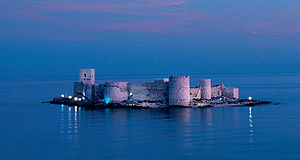- Corycus
-
This article is about the ancient city of Corycus in Cilicia. For other uses, see Corycus (disambiguation).
Corycus (Turkish: Kız Kalesi; Greek: Κώρυκος; also transliterated Corycos or Korykos; Armenian: Կոռիկոս) was an ancient city in Cilicia Trachaea, Anatolia, located at the mouth of the river called Şeytan deresi; the site is now occupied by the town of Kızkalesi (formerly Ghorgos), Mersin Province, Turkey.
The city
Strabo does not mention a town of Corycus, but reports a promontory so called at the location, but a town Corycus is mentioned by Livy (xxxiii. 20), and by Pliny (v. 27), and Pomponius Mela (i. 13), and Stephanus of Byzantium (s. v. Κώρυκος). In antiquity Corycus was an important harbor and commercial town. It was the port of Seleucia, where, in 191 BCE, the fleet of Antiochus the Great was defeated by the Romans. In the Roman times it preserved its ancient laws; the emperors usually kept a fleet there to watch over the pirates. Corycus was also a mint in antiquity and some of its coins survive.
Corycus was controlled by the Byzantine Empire. Justinian I restored the public baths and a hospital. Alexios I Komnenos re-equipped the fortress, which had been dismantled. At the beginning of the 12th century the Byzantines built a supplementary castle on a small island. This castle was later called "maidens castle" (Turkish: Kız kalesi), because it was told that a king held his daughter here in captivity until she was killed by a venomous snake. It was prophesied she would die by a snake bite. So she was taken to the sea castle to protect her, but a serpent was taken by basket to the castle, she was bitten and died. Corycus was conquered by the Armenians soon after it was rebuilt by the Byzantines. The Armenians held it until the end of the 14th century, as the last stronghold of the Armenian Kingdom of Cilicia. The city was then handed over to the Lusignans of Cyprus. It was taken by the Mamelukes, and again by Peter I of Cyprus. In the late 14th century it fell again to the Turks. From 1448 or 1454 it belonged alternately to the Karamanlis, the Egyptians, the Karamanlis a second time, and finally to the Osmanlis.
The ruins of the city are extensive. Among them are a triumphal arch, a necropolis with a beautiful Christian tomb, sarcophagi, etc. The two medieval castles, one on the shore, the other in an islet, connected by a ruined pier, are partially preserved; the former was reputed impregnable. The walls of the castle on the mainland contain many pieces of columns; and a mole of great unhewn rocks projects from one angle of the fortress about a hundred yards across the bay. Three churches are also found, one decorated with frescoes. The walls of the ancient city may still be traced, and there appear to be sufficient remains to invite a careful examination of the spot.
The city figures in the Synecdemus of Hierocles, and about 840 in Gustav Parthey's Notitia Prima. Ecclesiastically, it was a see, suffragan of Tarsus. Lequien (II, 879) mentions five Greek Orthodox bishops from 381 to 680; another is known from an inscription (Waddington, Inscriptions ... d'Asie mineure, 341). One Latin Bishop, Gerardus, was present at a Council of Antioch about 1136; four are known in the fourteenth century (Lequien, III, 1197; Eubel, I, 218). Corycus remains a titular see of the Roman Catholic Church, Coryciensis; the seat is vacant since the death of the last bishop in 1967. [1]
Corycian Cave
Main article: Arima, couch of TyphoeusIn the Corycian Cave (now Cennet ve Cehennem), 20 stadia inland, says Strabo, the best crocus (saffron) grows. He describes this cave as a great hollow, of a circular form, surrounded by a margin of rock, on all sides of a considerable height; on descending into this cavity, the ground is found to be uneven and generally rocky, and it is filled with shrubs, both evergreen and cultivated; in some parts the saffron is cultivated: there is also a cave here which contains a large source, which pours forth a river of pure, pellucid water, but it immediately sinks into the earth, and flowing underground enters the sea: they call it the Bitter Water. Pomponius Mela (i.13) has a long description of the same place apparently from the same authority that Strabo followed, but more embellished. This place is probably on the top of the mountain above Corycus.
This place is famed in Greek mythology. It is the Cilician cave of Pindar (Pythian Ode i. 31), and of Aeschylus (Prom. Vinct. 350), and as Arima, couch of Typhoeus, it is the lair of Zeus' fiercest opponent, the giant Typhon or Typhoeus.
References
- Smith, William (editor); Dictionary of Greek and Roman Geography, "Corycus", London, (1854)
- Blue Guide, Turkey, The Aegean and Mediterranean Coasts (ISBN 0-393-30489-2), pp. 550–51.
 This article incorporates text from a publication now in the public domain: Smith, William, ed (1854–57). "article name needed". Dictionary of Greek and Roman Geography. London: John Murray.
This article incorporates text from a publication now in the public domain: Smith, William, ed (1854–57). "article name needed". Dictionary of Greek and Roman Geography. London: John Murray. This article incorporates text from a publication now in the public domain: Herbermann, Charles, ed (1913). Catholic Encyclopedia. Robert Appleton Company.
This article incorporates text from a publication now in the public domain: Herbermann, Charles, ed (1913). Catholic Encyclopedia. Robert Appleton Company.
Coordinates: 36°27′55″N 34°09′15″E / 36.46528°N 34.15417°E
Categories:- Archaeological sites in Turkey
- Cities and towns of the Byzantine Empire
- Cilicia
- Ancient Greek sites in Turkey
- Roman sites in Turkey
- Roman colonies
- Titular sees
- Former populated places in Turkey
- History of Mersin Province
- Visitor attractions in Mersin Province
- Armenian Kingdom of Cilicia
Wikimedia Foundation. 2010.

